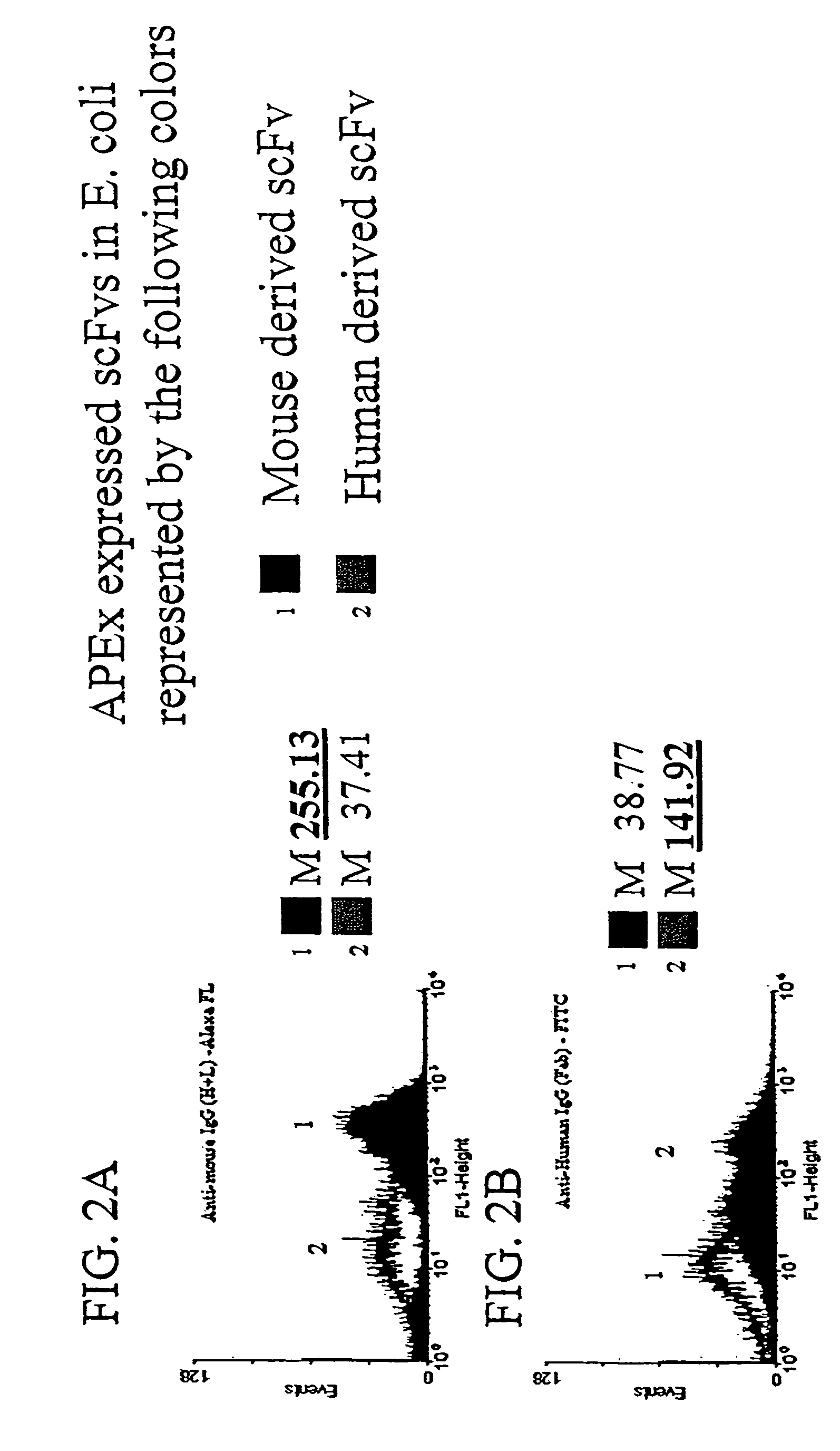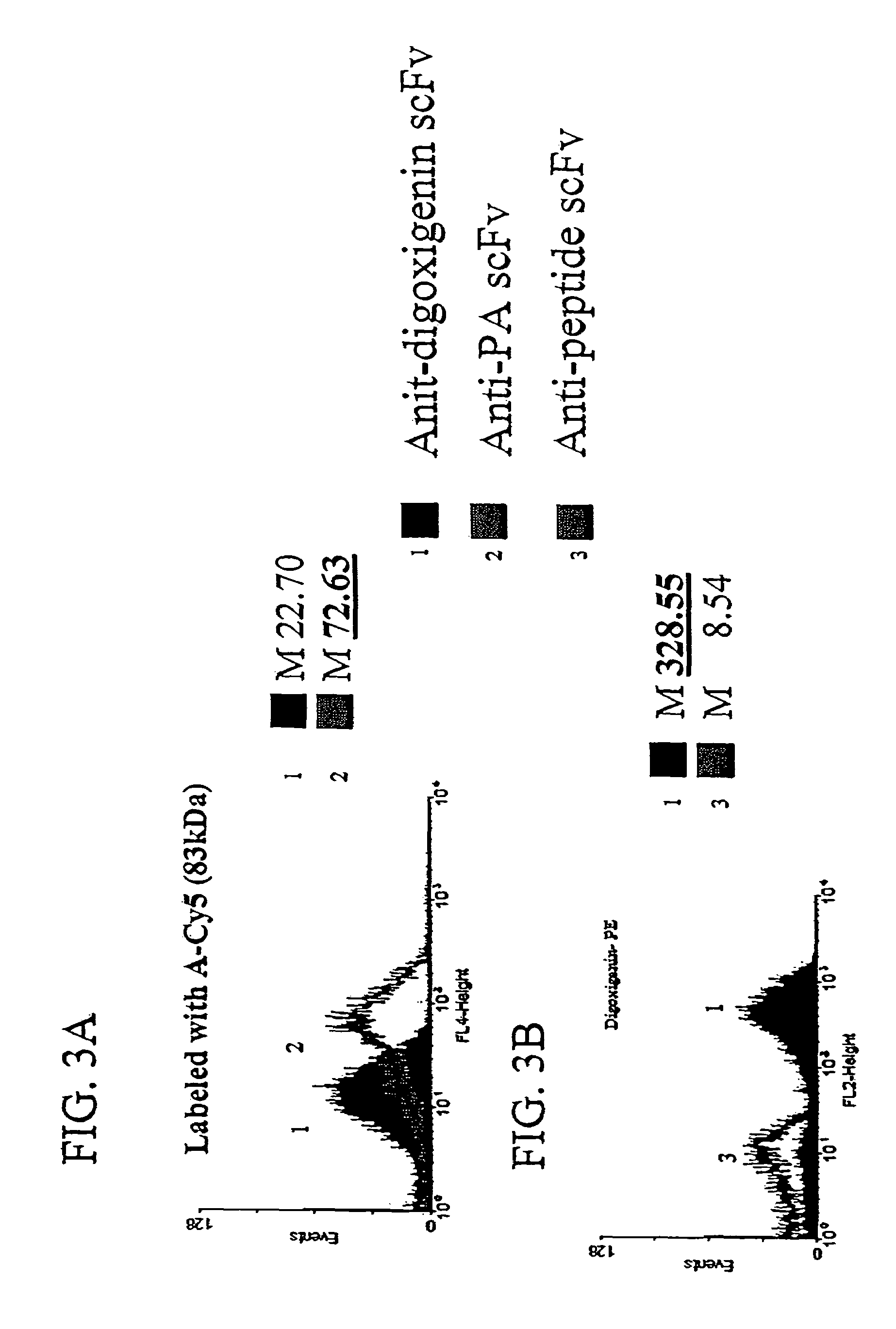Selection of bacterial inner-membrane anchor polypeptides
a technology of inner membrane and polypeptide, which is applied in the field of protein engineering, can solve the problems of difficult to produce clones after several rounds of panning, difficult to screen large libraries consisting of tens of millions or billions of clones, and complex screening of phage-displayed libraries
- Summary
- Abstract
- Description
- Claims
- Application Information
AI Technical Summary
Benefits of technology
Problems solved by technology
Method used
Image
Examples
example 1
Demonstration of Anchored Periplasmic Expression to Target Small Molecules and Peptides
[0124]The ability of scFvs displayed by APEx to target small molecules and peptides is shown in FIGS. 1A-1B and in FIG. 1C, respectively. Three cultures of Escherichia coli containing fusions of the first six amino acids of NlpA (to serve as a inner membrane targeting sequence for APEx analysis) to either an anti-methamphetamine, anti-digoxin, or anti-peptide scfv were grown up and induced for protein expression as described below. Cells of each construct were then labeled in 5×PBS buffer with 200 nM concentrations of methamphetamine-FL (FIG. 1A), digoxigenin-bodipy (FIG. 1B), or 200 nM peptide(18mer)-BodipyFL (FIG. 1C). The data presented shows a histogram representation of 10,000 events from each of the labeled cell cultures. The results demonstrate the ability of scfvs displayed by APEx to bind to their specific antigen conjugated fluorophore, with minimal crossreactivity to non-specific ligand...
example 2
Demonstration of Recognition of Ab Fragments by Anchored Periplasmic Expression
[0125]To demonstrate that the scFv is accessible to larger proteins, it was first demonstrated that polyclonal antibody serum against human Ab fragments or mouse Ab fragments would recognize scFvs derived from each displayed on the E. coli inner membrane by anchored periplasmic expression. Escherichia coli expressing a mouse derived scFv via anchored periplasmic expression (FIG. 2A) or expressing a human derived scFv via anchored periplasmic expression (FIG. 2B) were labeled as described below with either anti-mouse polyclonal IgG (H+ L)-Alexa-FL or anti-human polyclonal IgG (Fab)-FITC. Results (FIG. 2A, 2B) in the form of histogram representations of 10000 events of each demonstrated that the anti-human polyclonal (approximately 150 kDa in size) recognized the human derived scFv specifically while the anti-mouse polyclonal (150 kDa) recognized the mouse derived scFv.
example 3
Demonstration of the Ability of scFvs Displayed by Anchored Periplasmic Expression to Specifically Bind Large Antigen Conjugated Fluorophores
[0126]To demonstrate the ability of scFvs displayed via anchored periplasmic expression to specifically bind to large antigen conjugated fluorophores, E. coli were induced and labeled as described below expressing, via anchored periplasmic expression, an anti-protective antigen(PA) scFv (PA is one component of the anthrax toxin: a 83 kDa protein) or an anti-digoxigenin scFv. Histogram data of 10,000 events demonstrated specific binding to a PA-Cy5 antigen conjugated fluorophore as compared to the cells expressing the an anti-digoxigenin scFv (FIG. 3A). To further illustrate this point, digoxigenin was coupled to phycoerythrin(PE), a 240 kDa fluorescent protein. Cells were labeled with this conjugate as described below. It was found that E. coli (10,000 events) expressing the anti-digoxigenin scFv via anchored periplasmic expression were labeled...
PUM
| Property | Measurement | Unit |
|---|---|---|
| concentration | aaaaa | aaaaa |
| pH | aaaaa | aaaaa |
| OD | aaaaa | aaaaa |
Abstract
Description
Claims
Application Information
 Login to View More
Login to View More - R&D
- Intellectual Property
- Life Sciences
- Materials
- Tech Scout
- Unparalleled Data Quality
- Higher Quality Content
- 60% Fewer Hallucinations
Browse by: Latest US Patents, China's latest patents, Technical Efficacy Thesaurus, Application Domain, Technology Topic, Popular Technical Reports.
© 2025 PatSnap. All rights reserved.Legal|Privacy policy|Modern Slavery Act Transparency Statement|Sitemap|About US| Contact US: help@patsnap.com



